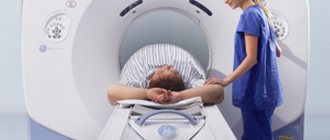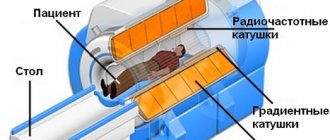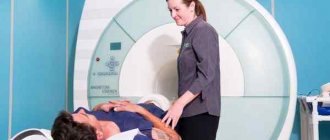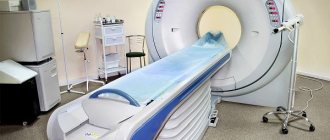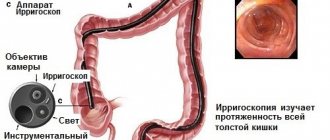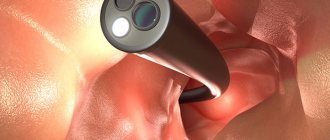Nowadays, when innovation delights us with the most modern technologies in any industry, high-quality equipment will help check the functioning of all organs of the human body and identify failures. There are several ways to detect diseases in the colon. With their help, you can detect the presence of fistulas, tumors, malformations, conduct diagnostics, and track changes in the course of a particular disease. To find out which is better - colonoscopy or irrigoscopy, you need to understand in more detail the intricacies of one and the other examination. But the preference when choosing still depends on the characteristics of the body and the symptoms of the disease.
Colonoscopy, its features
The main advantage of colonoscopy is that in most patients who undergo this procedure, it is possible to examine the condition of the entire large intestine. During the examination, a biopsy can be taken of those areas where there is any suspicion of disease, and the polyps can be removed immediately. If suddenly there is even the slightest suspicion of the presence of tumors in the large intestine, determining which is better - colonoscopy or irrigoscopy - depends only on the competence of the doctor.
In certain cases, it is best to start the study with irrigoscopy, and later, if the suspicion of a neoplasm is confirmed and you need to take the material for histology, you can use colonoscopy. It is this method that is considered to be the most accurate and is in demand for those severe cases when all previously used examination methods turned out to be ineffective. But in those “blind” areas, in the folds of the intestine and bends, colonoscopy is not effective.
These two intestinal studies have different capabilities and goals, and therefore it is impossible to give a specific answer to the question of which is better - colonoscopy or irrigoscopy. Both procedures make it possible to detect the disease early and prevent death.
The difficulty in identifying a cancerous tumor in the colon lies in the unsystematic growth of the tumor, which can be identified already in the last stages. Colonoscopy makes it possible to detect the inflammatory process in any part of the intestine and easily, without consequences, rid the patient of adenomatous polyps. This procedure is often performed only under anesthesia, as it is very painful and unpleasant.
Features, advantages and disadvantages of colonoscopy
The colonoscopy technique is a visual examination of the intestinal lumen using an endoscopic apparatus (colonoscope).
To assess the condition of the mucous membrane of the gastrointestinal tract, a special probe is used, which has a built-in camera, an additional tube for pumping air, as well as miniature surgical instruments used to take a biopsy and remove polyps. The main advantage of this diagnostic method is the high degree of visualization of the intestinal lumen in real time. Thanks to colonoscopy, it is possible to identify focal inflammatory changes at an early stage, polyps, intestinal diverticula, erosive and ulcerative lesions, benign and malignant neoplasms. In modern medical diagnostic practice, there is no complete alternative to colonoscopy. In addition to a high level of information content, this technique allows you to remove small tumors and stop bleeding. Along with the advantages of the colonoscopic technique for examining the intestines, there is a list of disadvantages that are important to consider before choosing a diagnostic method.
These disadvantages include:
- Severe discomfort and pain caused by the injection of air into the intestinal lumen and the advancement of the endoscopic tube along the entire length of the organ.
- High risk of traumatic damage to the intestinal walls due to insufficient qualifications of doctors or against the background of increased tone of the smooth muscles of the gastrointestinal tract.
- With a low threshold for pain sensitivity, patients may be advised to undergo anesthesia, which adversely affects the general condition of the human body.
- The impossibility of diagnosing using a colonoscope in young children and pregnant women.
Despite some shortcomings, colonoscopy remains a priority method for assessing the condition of the intestinal lumen.
Irrigoscopy: its characteristics
The main advantage of irrigoscopy is the ability to identify sections of the intestine in which narrowing is observed, indicate how it is located in the abdominal cavity, and divide its size. This diagnostic method involves filling the intestine with barium contrast and then photographing the part that follows using an x-ray. The resulting image will clearly show the anatomy of the intestine and quite large neoplasms in it, but you will not see inflammatory processes and the presence of polyps on it.
This research method is used if there is a suspicion of narrowing of the intestine, or if a person cannot tolerate a colonoscopy. This diagnosis is considered gentle and does not cause complications.
Pros, disadvantages and risks of different research methods
MRI of the intestine or colonoscopy, which is better? The table below will help you understand this in comparison.
| Research method | pros | Disadvantages and risks |
| MRI |
|
|
| CT scan |
|
|
| Colonoscopy |
|
|
| Virtual colonoscopy |
|
|
We suggest you read: How to cure a pimple on the eye
What are the differences between colonoscopy and irrigoscopy?
These two types of studies reveal malfunctions in the intestines and pathologies throughout the colon. Irrigoscopy or colonoscopy still have differences, and they lie in the diagnostic method itself.
Irrigoscopy is an X-ray examination, and colonoscopy is an endoscopic diagnostic test.
During irrigoscopy, the doctor takes pictures of the colon, after filling its entire cavity with barium sulfate. This solution fills the intestines and allows x-rays to better view intestinal pathologies. If you don't use it and take a photo, you won't see anything on it. Only from photographs can a doctor make a diagnosis.
During a colonoscopy, the diagnostician inserts a flexible tube into the patient's colon and uses it to examine the entire inner surface of the intestine, thereby identifying the affected area of the intestine. This diagnostic method allows not only to conduct an examination, but also makes it possible to carry out therapeutic manipulations:
- removal of polyps;
- stopping internal bleeding in the intestines;
- restoration of normal lumen in the intestine in the area of narrowing.
In addition, during this study, the doctor can take samples for histology and monitor the correctness of treatment. But it is quite difficult to accurately answer which is better - irrigoscopy or colonoscopy. Each of these techniques is good in its own area and helps in solving many problems.
What does irrigoscopy show?
- shape, location and diameter of the lumen of the colon
- distensibility and elasticity of the intestinal wall
- function of the bauhinium valve (this is an intestinal fold located at the junction of the ileum into the large intestine. Normally, it allows intestinal contents to pass in only one direction - from the small intestine to the large intestine, and if its function is disrupted, reflux is observed in the opposite direction. With irrigoscopy this is clearly visible by contrast movement)
- functional state of different parts of the intestine
- relief of the mucous membrane. This indicator is crucial in the diagnosis of ulcerative lesions, diverticulosis, fistulas, tumors, as well as congenital malformations and cicatricial narrowings of the large intestine.
What to choose?
Irrigoscopy or colonoscopy - which is better? If you compare these two diagnostic methods, the main thing you should pay attention to is the lack of a 100% guarantee on the accuracy of the data obtained. Neither one nor the second method can effectively identify all intestinal pathologies. But still, doctors give priority to colonoscopy.
Only it can provide reliable information about the internal state of the intestines and even allow you to obtain samples for further research, and in some patients it will even help remove polyps. But neither colonoscopy nor irrigoscopy will help make an accurate diagnosis.
Pros and cons of gut testing
Diseases associated with the intestines significantly affect a person’s quality of life. When choosing a diagnostic method, you should not postpone the study, and you need to choose only a high-quality examination.
Colonoscopy can be compared to tomography, and it provides more opportunities for in-depth examination and detection of a large number of pathologies. She also helps take biopsy samples and assists in treatment. This method is considered the most difficult; after it, the patient has the impression for some time that his stomach is swollen, but after a short period of time all symptoms disappear.
Irrigoscopy also has its advantages - this procedure is not so painful, and the degree of injury from it is minimal. This method is well suited in cases where it is difficult to check certain areas of the intestine – bends and pockets – using another method.
And the main disadvantages of diagnostics are contraindications to its implementation:
- intussusception;
- severe form of diverticulosis.
In cases where there is a suspicion of obstruction in the intestine, then irrigoscopy is performed using water-soluble substances, and this greatly affects the quality of the images.
Getting ready for irrigoscopy
Colonoscopy or intestinal irrigonoscopy require preliminary preparation of the body. Proper bowel preparation for the procedure will significantly increase the chances of accurate results.
Before going for irrigoscopy, the patient must follow a diet and cleanse the intestines. All foods that can cause bloating should be excluded from the diet for several days. You can't eat:
- Fresh vegetables and fruits.
- Barley.
- Wheat and oatmeal.
- Eliminate all types of greens and brown bread.
It is best to go on a steam diet for several days - dishes cooked only in a steam bath. Before the procedure, do not eat the evening before or in the morning.
As for cleansing procedures, accurate results of irrigoscopy can be obtained with a clean intestine, so the patient must take a laxative and do an enema.
Irrigoscopy
Having a need to examine the intestines, people often face a choice between irrigoscopy and colonoscopy. Which type of examination is better? To understand this, it is necessary to understand the features of these procedures. Colonoscopy is an endoscopic technique for examining the colon. The procedure is carried out using a fiberconoloscope - a special optical device, thanks to its flexibility and softness, the intestines are examined. A large number of people are wary of the procedure, believing unsubstantiated rumors that a colonoscopy can lead to colon rupture or fecal incontinence. However, all these arguments have no scientific confirmation, and the examination itself is safe for the patient. At the end of the fibercoloscope there is a light source and a microcamera, with the help of which a specialist can: Preparation for colonoscopy begins 2 days in advance and, just like before irrigoscopy, is aimed at cleansing the intestines with the help of a special diet and laxatives prescribed by the attending physician. Irrigoscopy is another method of examining the colon using a contrast agent and x-rays, which can detect a large number of diseases of the gastrointestinal tract.
The material for the site was prepared by Albina Artashevna Avanesyan, endoscopist, candidate of medical sciences, head of the endoscopy department of the Oncology Center.
Getting ready for a colonoscopy
Irrigoscopy or colonoscopy, which is better? Each of these diagnostics is good in its own way and you must be well prepared for each of them, only in this case you can obtain more accurate research data.
Preparation is needed in order to cleanse the intestines to accurately examine all its areas and identify narrowing. There should be no feces, gases, blood or mucus in the intestines; only in this case can you examine every centimeter of the intestines without any problems. This is a general condition that is stated in any diagnostic center or hospital, wherever the medical institution is located, public or private.
For example, irrigoscopy or colonoscopy in St. Petersburg under compulsory medical insurance is carried out only after a three-day diet. Before a colonoscopy, the patient can eat:
- low-fat broths and only in second water;
- boiled beef, chicken, including fish;
- cottage cheese and kefir;
- unhealthy cookies and white bread.
It is better to completely avoid all other products, including fresh vegetables and fruits. Such a strict diet has never harmed anyone, but it has made it possible to conduct an examination of the intestines with maximum accuracy.
Before going for a colonoscopy, the patient should not have dinner or breakfast; you can drink water or tea, take a laxative and do a cleansing enema.
There are also medications that will help prepare the intestines for colonoscopy:
- "Fortrans".
- "Duphalac".
- "Lavacol."
These are all laxatives and will help cleanse your colon easily and without further discomfort.
Patient reviews about diagnostics
When it comes to examining the intestines, the question arises: irrigoscopy or colonoscopy - which is more informative? It is difficult to give an exact answer. This depends on many factors: the patient’s condition, disease. It is impossible to say for sure which is better - colonoscopy or intestinal irrigoscopy, since each person has his own body and his own symptoms. If it was possible to identify the disease in one patient using one method, then it may not be of much help to another. For everyone, a certain diagnostic method is effective - colonoscopy or irrigoscopy. Patient reviews vary. Some people note the painful sensations, others, on the contrary, the simplicity of the procedure. In general, patients respond positively to both methods. The main thing, as we have already said, is to properly prepare for one and the other procedure in order to get the most accurate answers to all questions regarding the functioning of the intestines.
CT or traditional colonoscopy?
What is better, CT scan of the intestine or colonoscopy? Actually, the patient should not ask such a question. If he turns to a competent specialist, the doctor decides on the choice of the type of examination based on the specific situation: the clinical picture, indications and contraindications, the presence of provoking factors, as well as the equipment of the medical center in which the patient is being examined.
Perhaps this is the reason for the high prevalence of traditional colonoscopy. However, it is impossible to talk about the latter method solely in a negative way. Often, a virtual colonoscopy reveals signs of disease, but there may not be true evidence of such suspicions. The patient also needs to undergo a colonoscopy to take a biopsy of part of the intestinal mucosa.
We have to admit that there is no real winner in this medical diagnostic battle and cannot be. Traditional and virtual colonoscopy are tools to help obtain a diagnosis, and only the doctor will decide whether the patient needs a colonoscopy or a CT scan.
We invite you to familiarize yourself with White spots on the skin and body, what they are and how to treat them: tips and methods
